Now on the shelves in the UK, the Fujifilm FinePix F31fd represents a fairly minor update to last year’s F30 zoom, sporting the same impressive low light performance, courtesy of Fujifilm’s 6th-generation Super CCD and RP Processor II.
 As with the F30, the 6.3 megapixel F31fd comes with a 3.0x optical zoom, super-high ISO 3200 sensitivity at full resolution, long-life battery (up to 580 shots), VGA movie recording up to 30 frames per second and Aperture & Shutter priority shooting plus a shedload of scene modes.
As with the F30, the 6.3 megapixel F31fd comes with a 3.0x optical zoom, super-high ISO 3200 sensitivity at full resolution, long-life battery (up to 580 shots), VGA movie recording up to 30 frames per second and Aperture & Shutter priority shooting plus a shedload of scene modes.
Sporting a redesigned, curvier body than its 2005 predecessors – the Fujifilm F10 and F11 snappers – the F31fd also adds a hardware-based Face Detection technology and infrared connectivity for sharing photos.
Boat race recognition
First seen in the company’s FinePix S6500fd’s bridge camera, Fujifilm’s Face Detection system is claimed to be able to identify faces, optimise settings and fire off a photo within just 0.05 seconds.
 Capable of handling up to ten grinning faces in a frame, the technology should put an end to out of focus pictures, even when documenting a heavy night of quaffing in the old Bull and Bush.
Capable of handling up to ten grinning faces in a frame, the technology should put an end to out of focus pictures, even when documenting a heavy night of quaffing in the old Bull and Bush.
To be honest, we weren’t exactly convinced of the benefits of the technology and would suggest that anyone used to focusing and reframing shots might as well buy the cheaper F30.
No looker
As with previous models, the Fujifilm is something of a plain, bulky fella unlikely to find favour with camera aesthetes, but behind those ordinary looks lurks some impressive picture taking capabilities.

Along with the astonishing battery life – rated at around 580 shots per charge – the F31fd comes with a crisp and sharp 230,000 pixels, 2.5-inch screen LCD screen but, sadly, no optical viewfinder.
The 3x zoom lens covers a respectable 36-108mm (35mm equiv), with the aperture starting quite brightly at F2.8, closing down to a not-so-hot F5.0 at the telephoto end.
We would have preferred a bit more at the wide angle end, but at least Fujifilm have junked the annoying ‘terminal adaptor’ seen on the F10 and F11 cameras and fitted a proper DC port for the (supplied) mains adaptor.

Unfortunately, the company has stuck with the XD card format, something that may put off potential buyers who have already aqcuired a collection of the more common SD card.
View from the top
On the top of the camera is a rather fiddly mode dial offering Movie, A/S (aperture and shutter priority), Rec-Manual, Rec-Auto, Scene and ‘anti blur’ (which simply ramps the ISO rating up rather than providing any proper optical stabilisation).
Also on the top plate is the shutter release button and power on/off control.
As with previous models, the F31fd is very quick to start up, with the camera ready to shoot in under 2 seconds.
On the back
Next to the LCD screen on the back is a 4-way controller for navigating menus, surrounded by four additional buttons with a zoom in/out rocker switch above.

Sitting in the bottom right hand corner is the button to activate the Face Detection system, which also doubles up as a useful exposure +/- control when in manual mode.
Using the F31fd
Once again, the Fujifilm excelled in low light and high ISO output, producing usable images when most of its rivals would be churning out grainy snowstorms of digital noise, making this an ideal camera for nights out.
We were able to get excellent results up to 400ISO, with even ISO 800 images remaining usable, although the built in AF illuminator didn’t stop us suffering quite a few out-of-focus grabbed shots in low light.
Daytime shots featuring lots of contrast could sometimes throw up the occasional over-exposed picture, but with a bit of care the F31fd was capable of excellent results.
 The lack of real manual controls was a bit frustrating and we continue to find Fujifilm’s interface a little less intuitive than some of its rivals, but point’n’shooters should have no problem getting to grips with the camera.
The lack of real manual controls was a bit frustrating and we continue to find Fujifilm’s interface a little less intuitive than some of its rivals, but point’n’shooters should have no problem getting to grips with the camera.
However, all these minor niggles don’t stop us highly recommending the F31fd, with the camera offering class-leading low light performance, fast start up times, good flash performance and a sturdy build that should last for years.
Features: 80%
Ease of Use: 65%
Image Quality: 85%
Overall: 85%
Specifications
Number of effective pixels 6.3 million
CCD 1/1.7″ Super CCD HR
Image sizes: 2,848 × 2,136, 3,024 × 2,016 (3:2), 2,048 x 1,536, 1,600 x 1,200, 640 × 480
File format JPEG (Exif)
Storage media Internal memory (approx. 26MB) xD-Picture Card
Lens focal length 36-108 mm
Sensitivity AUTO / Equivalent to ISO 100/200/ 400/800/1600/3200
LCD 2.5″ Amorphous silicon, TFT 230,000 pixels
Movie Recording 640×480 / 320×240 pixels, 30 frames / sec with monaural sound
Voice memo Yes
Video output NTSC & PAL
Digital interface USB 2.0 (High-speed)
Power source NP-95 Lithium-ion battery, AC Power Adapter
Dimensions (W x H x D) 92.7 x 56.7 x 27.8 mm
Weight (approx./excluding battery and memory card) 155g
Fujifilm F31fd
 The open source Mozilla Firefox browser enjoyed a whopping increase of nearly 50% during 2006, according to Web measurement firm, Net Applications
The open source Mozilla Firefox browser enjoyed a whopping increase of nearly 50% during 2006, according to Web measurement firm, Net Applications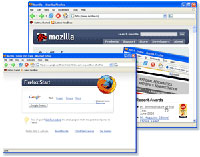 For every winner there has to be a loser or two, and in this case it was Microsoft, who saw their market share slump to 79.6% from 85.1% at the start of 2006, despite the release of an update to Internet Explorer last year.
For every winner there has to be a loser or two, and in this case it was Microsoft, who saw their market share slump to 79.6% from 85.1% at the start of 2006, despite the release of an update to Internet Explorer last year. Elsewhere, Opera grew its share to match Netscape, up from 0.6% at the beginning of the year.
Elsewhere, Opera grew its share to match Netscape, up from 0.6% at the beginning of the year.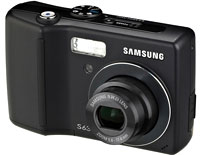 Samsung have gone new-camera bonkers, unleashing a veritable pack of seven new snappers, all set to be hitting the shelves this Spring.
Samsung have gone new-camera bonkers, unleashing a veritable pack of seven new snappers, all set to be hitting the shelves this Spring.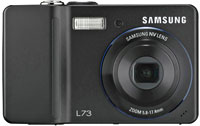 Rather a sleek and seductive number in an all black finish with a saucy blue trim, the S1050 delivers impressive video functionality, managing to record movies up to 800 x 600 at a baby’s-bum-smooth 30fps.
Rather a sleek and seductive number in an all black finish with a saucy blue trim, the S1050 delivers impressive video functionality, managing to record movies up to 800 x 600 at a baby’s-bum-smooth 30fps.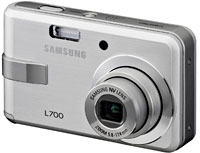 First seen in
First seen in 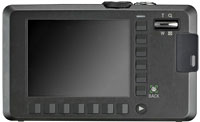 Making up the septet of new snappers is the curious-looking i70, a multimedia-packed little fella with a sliding cover offering a
Making up the septet of new snappers is the curious-looking i70, a multimedia-packed little fella with a sliding cover offering a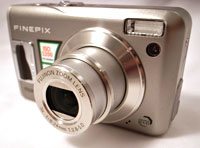 As with the F30, the 6.3 megapixel F31fd comes with a 3.0x optical zoom, super-high ISO 3200 sensitivity at full resolution, long-life battery (up to 580 shots), VGA movie recording up to 30 frames per second and Aperture & Shutter priority shooting plus a shedload of scene modes.
As with the F30, the 6.3 megapixel F31fd comes with a 3.0x optical zoom, super-high ISO 3200 sensitivity at full resolution, long-life battery (up to 580 shots), VGA movie recording up to 30 frames per second and Aperture & Shutter priority shooting plus a shedload of scene modes.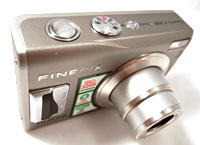 Capable of handling up to ten grinning faces in a frame, the technology should put an end to out of focus pictures, even when documenting a heavy night of quaffing in the old Bull and Bush.
Capable of handling up to ten grinning faces in a frame, the technology should put an end to out of focus pictures, even when documenting a heavy night of quaffing in the old Bull and Bush.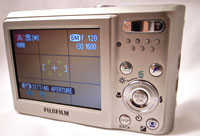
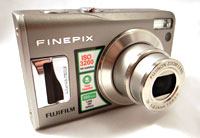
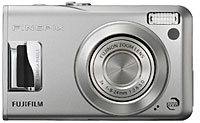
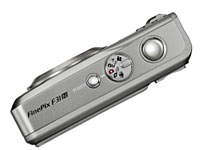 The lack of real manual controls was a bit frustrating and we continue to find Fujifilm’s interface a little less intuitive than some of its rivals, but point’n’shooters should have no problem getting to grips with the camera.
The lack of real manual controls was a bit frustrating and we continue to find Fujifilm’s interface a little less intuitive than some of its rivals, but point’n’shooters should have no problem getting to grips with the camera. Samsung has launched what it claims is the first mobile phone in the known universe to come with an optical joystick.
Samsung has launched what it claims is the first mobile phone in the known universe to come with an optical joystick. The slide-open phone also comes with an illumination sensor which automatically controls the brightness of the LCD screen and keypad, so you won’t be dazzled if the phone goes off in the middle of the night.
The slide-open phone also comes with an illumination sensor which automatically controls the brightness of the LCD screen and keypad, so you won’t be dazzled if the phone goes off in the middle of the night. Rock Bottom: Nikon D40 £400 (with lens)
Rock Bottom: Nikon D40 £400 (with lens)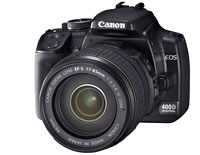 Budget: Canon EOS E400D (£500 body-only)
Budget: Canon EOS E400D (£500 body-only)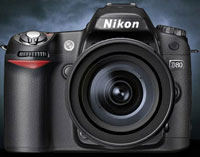 Enthusiast: Nikon D80 (£600 body only)
Enthusiast: Nikon D80 (£600 body only) MySpace and Cingular Wireless have pressed the flesh and announced an exclusive partnership to offer enhanced MySpace functionality to all Cingular mobile users.
MySpace and Cingular Wireless have pressed the flesh and announced an exclusive partnership to offer enhanced MySpace functionality to all Cingular mobile users. MySpace Mobile also lets users post to their MySpace blogs when they’re on the move, as well as add friends to a contact list for quick bookmarking.
MySpace Mobile also lets users post to their MySpace blogs when they’re on the move, as well as add friends to a contact list for quick bookmarking. While announcing the release 3.0 of their VoIP software, Skype have unveiled the US Unlimited Calling Plan.
While announcing the release 3.0 of their VoIP software, Skype have unveiled the US Unlimited Calling Plan. Those Europeans who are surprised that calls to mobiles are included, should know that in the US owners of mobile pay to receive calls, so callers don’t pay extra to make them.
Those Europeans who are surprised that calls to mobiles are included, should know that in the US owners of mobile pay to receive calls, so callers don’t pay extra to make them.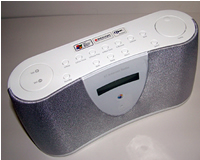 With last week’s launch of it’s TV over the Internet service, a raft of integrated net-based services and a slew of new hardware devices, BT has relauched itself as a multi-media service provider instead of a plain old utility company. The BT Internet Radio shows another face of BT’s rebranding. It’s a slickly designed consumer electrical product aimed directly at the growing digital radio sector.
With last week’s launch of it’s TV over the Internet service, a raft of integrated net-based services and a slew of new hardware devices, BT has relauched itself as a multi-media service provider instead of a plain old utility company. The BT Internet Radio shows another face of BT’s rebranding. It’s a slickly designed consumer electrical product aimed directly at the growing digital radio sector. Choosing between stations is a bit of a hit and miss affair. If your tastes tend towards anything beyond the mainstream categorizations (rock, pop, dance, hip hop etc) you’ll struggle to find the music you want to hear. This, of course, isn’t BT’s fault. The device uses the Reciva Internet Portal to aggregate its stations. If you access the Reciva Website (
Choosing between stations is a bit of a hit and miss affair. If your tastes tend towards anything beyond the mainstream categorizations (rock, pop, dance, hip hop etc) you’ll struggle to find the music you want to hear. This, of course, isn’t BT’s fault. The device uses the Reciva Internet Portal to aggregate its stations. If you access the Reciva Website (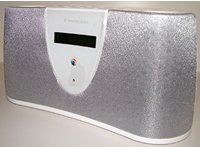 The device can access and playback MP3 or other audio files from a networked PC. An extremely useful feature and one that really capitalizes on the network power of the unit. It probably would have done the most to sell this device to me. In practice it was unable to connect to my PC so I had to leave the feature untested. Typically, macs are not supported and I was unable to access my sizable MP3 collection via either of the macs on the network. It’s not surprising that BT have chosen to adopt Windows technology for integration with computers but it is disappointing that they couldn’t have adopted an interoperable standard which would have supported any operating system.
The device can access and playback MP3 or other audio files from a networked PC. An extremely useful feature and one that really capitalizes on the network power of the unit. It probably would have done the most to sell this device to me. In practice it was unable to connect to my PC so I had to leave the feature untested. Typically, macs are not supported and I was unable to access my sizable MP3 collection via either of the macs on the network. It’s not surprising that BT have chosen to adopt Windows technology for integration with computers but it is disappointing that they couldn’t have adopted an interoperable standard which would have supported any operating system.